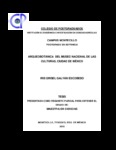Arqueobotánica del museo nacional de las culturas, Ciudad de México
Abstract
El Museo Nacional de las Culturas (MNC) ubicado en el centro histórico de la ciudad de México, es un edificio que fue construido en 1734 sobre los restos de la antigua ciudad de México -Tenochtitlán habitada por los mexicas (1324-1521). En el MNC se realizaron excavaciones arqueológicas con el objeto de recuperar información histórica relacionada con el sitio, tendientes a una restauración integral del edificio y su posterior adecuación museográfica. De los trabajos arqueológicos se derivó esta tesis que tuvo como finalidad recuperar los restos vegetales contenidos en los depósitos sedimentológicos de las excavaciones arqueológicas, para establecer las condiciones paleoecológicas de la región y el posible uso de plantas. Se analizaron 50 muestras de sedimento de las excavaciones del MNC, que cronológicamente corresponden a finales de la época prehispánica y a la época colonial. De dichos sedimentos se recuperaron semillas y fragmentos de madera, que representaron a 36 géneros integrados en 26 familias de los cuales se pudo inferir el uso de algunas plantas principalmente con fines alimenticio y en construcción, así como algunas otras que nos hablan de la vegetación de la región. En dos de las calas se realizó un muestreo exploratorio para evaluar la presencia de granos de polen. Los resultados mostraron una presencia reducida de polen, por lo que no fue posible hacer una reconstrucción de la vegetación con base en esta información. Sin embargo, los palinomorfos encontrados manifiestan el predominio de un ambiente lacustre. El Análisis de Componentes Principales aplicado a los macrorrestos vegetales, no muestra relación de los taxa identificados con la profundidad y su distribución en el espacio y en el tiempo. _______________ ARCHAEOBOTANY FROM THE NATIONAL MUSEUM OF CULTURES, MEXICO CITY. ABSTRACT: The building of the National Museum of Cultures (NMC), located in the historical center of Mexico City, was constructed in 1734 on top of the remains of the ancient city of Mexico-Tenochtitlan, where the mexicas used to live (1324-1521). Archaeological excavations were carried out in the grounds of the NMC with the goal of recovering historical information in order to establish plans for an integral restoration of the building and its later museographic adaptation. This thesis was derived from these archaeological works with the goal of recovering plant remains contained within the sediment deposits of the archaeological excavations in order to establish the paleo-ecological conditions of the region and the possible use of the plants in ancient times. Fifty sediment samples from the excavations in the NMC were analyzed, which corresponded, chronologically, to the end of the prehispanic period and the beginning of the colony in Mexico. From these sediments, seeds and wood samples were recovered, representing 36 genres set in 26 families from which the use of some plants was inferred. The uses were mainly for food and building purposes. Other samples give information on the plant life of the region. Exploratory samplings were done in two of the digs to evaluate the presence of pollen. The results showed a low presence of pollen, and thus it was impossible to make a proper reconstruction of plant life based on this information. However, the palynomorph remains found show a predominant lacustrine environment. The Main Component Analysis applied to vegetable macroremains shows no relationship between the identified taxa with the depth of the dig, or their space-time distribution.
Collections
- Tesis MC, MT, MP y DC [182]

